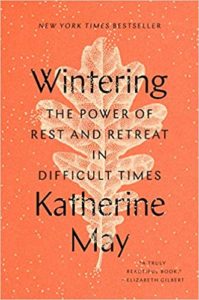Wintering By Katherine May
For most of my life, my only experience of winter has been through children’s books and Christmas carols. Where’s my snow? In Narnia. Where are my jingle bells? The ones I would think about while roller skating on a neighbor’s driveway in days gone by, singing, “I’m dreaming of a white Christmas, just like the ones I LONG to know.”
One February morning I got my wish: Waco received two inches of perfect snow and no ice. My kids built a snowman, and so, it seemed, did everyone else. That afternoon it warmed up enough for me to ride my bike, and I counted forty-two snowmen.
But then this past February two pivotal things happened simultaneously. First, I got the winter I’d been longing for my entire life, courtesy of Winter Storm Uri (which was a bit more than I bargained for). And second, I started reading Wintering by Katherine May.
The book opens with an epigraph, a poem by Edward Thomas. It features birds— rooks, in this case, — a topic to which May returns often.
Thaw
Over the land freckled with snow half-thawed
The speculating rooks at their nests cawed
And saw from elm-tops, delicate as flowers of grass,
What we below could not see, Winter pass.
–Edward Thomas
In Wintering, May opens the door to winter, settles in, then watches it pass. She lets it teach her, and us, how to winter. May uses the word wintering as a metaphor, applying the meteorological season to a season of life. It’s not necessarily the hardest season, not the one that pushes us beyond our limits, although that can usher in a wintering. It’s the one in which we lie “fallow.” No more to do. Wait for spring.
Wintering is a memoir, but I’ve never read a memoir that revealed less about the author and yet left me feeling so satisfied. For example, there are only three sentences mentioning her adult diagnosis of autism, and they’re not even all together in one place. But Wintering is also more than a memoir. It’s a meditation on the physical realities of winter — of Iceland and Norway and snow and all the wintery holidays. It looks at poems and books and animals to teach us how to winter.
The book is also unusual in that it doesn’t unfold chronologically. That is to say, it is arranged chronologically — stretching from September to March — yet the examples of wintering in May’s own life weave in and out of time. Here she is pregnant. There she is childless. Here she is contemplating schooling options for her son. I never once felt the least bit lost.
I did not know that I was reading the book in preparation for a new wintering season of my own, one which would begin a few months later, in high summer. Suddenly, like May, I was “cut off from the world, feeling rejected, sidelined, blocked from progress, or cast into the role of an outsider.”
This time, I did not panic. Like May:
I recognized winter. I saw it coming (a mile off, since you ask), and I looked it in the eye. I greeted it and let it in.”
It is still winter, in every possible way. I am letting the rooks teach my heart to survive, however long it decides to stay.
Will you join us for our “Wintering” book club? Become a Patron to join us.
We’ll be reading on a schedule that follows the calendar, from fall to winter to spring.
February 9: Hot Water & Starlings (Prologue-September-October-November)
February 16: Cold Water & Gulls (December-January-February)
February 23: Thaw & Lapwing (March-Late March)
Photo by Bernard Spragg NZ, Creative Commons, via Flickr. Post by Megan Willome.
Browse more book clubs
I loved this book. As soon as I finished, I began reading it again.”
—David Lee Garrison, author of Playing Bach in the D. C. Metro
- Perspective: The Two, The Only: Calvin and Hobbes - December 16, 2022
- Children’s Book Club: A Very Haunted Christmas - December 9, 2022
- By Heart: ‘The night is darkening round me’ by Emily Brontë - December 2, 2022



Leave a Reply